Latest Forum Topics /
GLD USD
Last:384.99
 -4.51
-4.51
|
|
|
Gold & metals
|
|
|
bsiong
Supreme |
10-Mar-2011 16:39
Yells: "The Greatest Wealth is Health" |
|
x 0
x 0 Alert Admin |
Gold: In like a lion, out like a Bull Published on: March 10, 2011 at 12:45By Renisha Chainani Will Commodities continue to steamroll into new highs making considerable gains or will the struggling dollar reaching record lows make a showdown, putting a ceiling on the price rise? Dollar: No longer safe heaven asset in 2011 Investors are jumping into precious metals as a safe haven, causing record breakouts. The dollar on the other hand has shown no interest from safe-haven buyers. The dollar, which proved to be a safe haven during 2008, has not been showing similar characteristics in 2011. Many investors are concerned about a repeat of 2008, where commodities and precious metals suffered a severe decline along with the markets. It is my belief that 2011 is different as evidenced by the recent decoupling of gold and the dollar as a safe haven. Central banks are addicted to quantitative easing now. There are no exit strategies as long as unemployment does not improve. Quantitative easing has never been successfully used before. It may work in the academic world, but in the financial world it is causing a dollar debasement exacerbating fragile geopolitical issues globally. The only precursor of quantitative easing to my knowledge is Japan, which has used it since 2001. Japan is still in a recession and suffering with sovereign debt issues. Dollar Index is heading towards low of 74.20 touched in late 2009 with the final target of 71 in 2011. 2010: Major breakout year for silver Some naysayers claim that there is a danger of gold and silver rising into areas that may be considered a blow off and that risk of a severe downturn is too high. The price of silver has been reaching areas that exceed the squeeze engineered in 1980 by the Hunt Brothers. It is true gold is entering new record territory and there may be areas of profit taking, but one must not deny that 2010 was a major breakout year for silver, proving that the long-term silver bulls have been right The true believers argue that there are too many positives going for silver at this time. We know that it is a truism that in times of political and economic instability silver represents a storehouse of value. Moreover, silver is profiting from soaring global inflation rates and political fever on the rise in the Middle East and North Africa. Silver also serves as an industrial metal with more than half of its demand driven by manufacturing. Electronics and solar power areas are active users of silver and are fueling the rise in demand for the precious metal. Silver’s critics rebut that technically silver futures are moving into overextended territory. Compared to gold, the small size of the silver market renders it more volatile than the yellow metal. This results in historically greater volatility, causing soaring rallies and breathtaking corrections than might be seen in gold. Silver has often been called poor man’s gold. This demonstrates that the average investor is being driven to hedge with precious metals. This places downward pressure on the gold-silver ratio. Investors are seeking to own hard assets. Silver is caught up by the tensions in the Middle East and the fear on inflation. The desire to own precious metals and lack of faith in their own currencies throughout the world is an important factor in the flight to silver. The possibility that central banks may be caught by their maintenance of zero interest rates represent the go-ahead signal for silver. After consolidating for several months in a range, Silver prices broke out the silence and rallied from Sep 2010 and since then there are no looking back except few corrections for the rally to sustain. Silver's bullish scenario will be consistent if it sustains $36.60 for the target of $39.75-$40. Near term support is $34.60, if that is broken we might see prices falling to $32.Gold: In Like a Lion, Out Like a Bull We witnessed yet another historical event when gold prices traded to a new record high. Breaking the former record of $1434, gold traded to an intraday high of $1445. Safe-haven demand is being spurred by higher oil prices due to the continued unrest in the MENA Region. With oil over a $100 a barrel, investors are scared to death of inflation. They're looking for a safe place to park some of their assets. Gold and silver are very attractive to those who are risk-adverse. Gold is continuous uptrend channel since Oct 2008 and is likely to touch $1600 in 2011, if the support $1350 does not breaks. Near-term support is $1420 and resistance is $1500. Gold Silver ratio: Below 40 The gold/silver ratio fell now below 40 for the first time since the 80's. The last time the gold: silver ratio stood below 40:1 was in 1984, just after silver had staged a 33% rally in five weeks, while gold had gained just 4% over the same period (which commenced at the start of the year). The contraction in the ratio over the period was from 48:1 to 39:1. This time however, gold and silver are trading at over $1,440 and $36, while back in 1984 they were at $400 and just over $9. While both gold and silver prices are rising, silver has outperformed gold as indicated by the falling gold/silver ratio. While the metals are close substitutes in investment and jewelry application, silver has more industrial uses than gold. Therefore, the white metal has benefited more from strong demand from emerging markets. Indeed, silver tends to outperform gold when commodity prices are rallying and the financial markets are in a 'risk-on' mode. Conversely, gold usually performs better when risk appetite dims and investors seek safe-haven investments. That said, we may not see gold/silver return to levels previously seen as silver has been an increasingly popular investment instrument during turmoil and uncertainties.Crude Oil soaring due to Unrest in MENA Since the crisis in Middle East and North Africa (MENA) actuated, crude oil prices rose almost 25% heading straight from $85 to $107. The only reason behind this big spike in the prices was the fears of supply disruption and production shut resulting in the shortage in the oil market. While it's uncertain how much of Libya's daily production of around 1.6M bpd is disrupted (IEA estimated that 30-50% was cut while Italy's ENI said that 75% is cut), large oil companies have reportedly trimmed their outputs by a great deal. The higher crude oil prices costs world economy in terms of higher inflation with high fuel prices which affects millions and trillions of people badly. The sudden hike in oil prices also pressured equity markets resulting in major down fall in the world equity indices. As almost 40% of oil supply comes from MENA, the event caught the thousands of eye balls concerning higher oil prices and mounting inflation threat. The United Nations estimated as of Feb. 26 that 1,000 people had died since the Libyan uprising began in mid-February. In Saudi Arabia, websites have called for a nationwide “Day of Rage” on March 11 and March 20, according to Human Rights Watch. Therefore if tensions intensify, Crude Oil will continue its bull run with resistance being $110 and $120. But as MENA tensions boil down in future, Crude Oil prices might rest around $85. Tunisia, Egypt, Libya…Who Next? It is tempting to look at the events in Tunisia, Egypt and Libya and, as shocking as the loss of life and bloodshed have been, at least console ourselves that this is a Middle Eastern problem, a product of decades of autocratic rule on a people who have only recently benefited from wider access to education, the Internet and rising aspirations. The impact on the oil price and on gold have been dramatic on the upside, while stock markets have taken a hammering as a consequence of fears over the impact a higher oil price could have on the global economies Throughout our modern history we have heard about a " Domino effect," this inspired wars in Indochina in the 1960's, the age of military dictatorships in Latin America in the 1970's, and the collapse of Communism in the late 1980's. 2011 is the year of revolt in the Middle East, and perhaps beyond, but the big question remains which countries may fall like dominoes after the successful revolts in Tunisia, and Egypt? 1. Yemen At the forefront of the USA's " War on Terror," the Yemen is a poor, tribal and deeply divided country. This often places the Western backed dictator at odds with those isolated by the establishment and being a tribal society, pities tribe against tribe. If Yemen, does see the demonstrators continue to revolt against the regime- a Libyan scenario could evolve, with civil war or even a division of the country. 2. Bahrain One of the wealthiest oil wealthy countries in the Gulf, Bahrain has been rocked with sometimes violent demonstrations against the ruling Monarch. This in part has been contained but the grievances of the demonstrators share the common theme of unemployment, lack of freedom, and alleged discrimination against a repressed tribal majority, ruled by a minority tribe. 3. Iran In many ways Iran is a divided country, between those who support the aims of the 1979 revolution, and a majority of young, unemployed people who feel they have not benefited from the change in 1979. Perhaps there is a division between the establishment and a restless youth who want jobs, and more say in how their government is run. Any revolt in Iran could be as bloody as in Libya, unless both groups seek a solution, through dialogue. 4. Algeria The last free election in Algeria was annulled by a 1970's style secular military coup, and led to almost 20 years of conflict. Algeria has a young population, facing high unemployment and little say in how their country is run. Many experts place Algeria facing the same social problems as Tunisia, before the revolt, except a silent majority of Algerians do not want a return to the chaos of the 1990's, and are weary of conflict. One solution is dialogue, and reforms. 5. Poor Europe A country can look " rich," but at the same time suffer " hidden poverty." Greece, Ireland, Portugal, and Spain are becoming poor Europe, but also behind the shiny facades of many American, British and German cities, lays an increasing wealth gap, leading to belief that the system has failed. Poor Europe could eventually rise against 'wealthy' Europe, unless economic reforms leading to business and employment opportunities are created for a new generation staring at economic and social decline. 6. STANS Largely overlooked so far is the possibility of unrest in one of the many ex-Soviet central Asian republics, the “Stans” as they are sometimes collectively known. Kazakhstan, Uzbekistan and Tajikistan, are all ruled by despots or strongmen with no interest in the democratic process, as is ex-Soviet Belarus. Nursultan Nazarbayev has ruled Kazakhstan and Islam Karimov Uzbekistan since 1989. Emomali Rakhmon has run Tajikistan since 1992. They all have disgruntled populations, are deeply corrupt, suffer from widespread nepotism and many have fractious religiously diverse societies – sound familiar? These countries are major sources of natural gas, oil and coal, but also iron ore, chromium, bauxite & aluminum, copper, gold, lead and zinc. While these countries tend to look more towards the unrest in neighboring Georgia and Ukraine than the Middle East, we should not underestimate the impact Tunisia and Egypt have had on populations everywhere. Unlike those countries, though, access to the Internet is very limited and foreign news channels are often not available, so the sensor has more opportunity to control events. Nevertheless, a breakdown of order in one could domino to others with profound implications for commodities supply. Conclusion Gold, Silver and Crude Oil are expected to stampede while Dollar Index and Gold/Silver Ratio are expected to showdown more. Gold is in continuous uptrend since Oct 2008 and is likely to touch $1600 in 2011, if the support $1350 does not breaks. Near-term support is $1420 and resistance is $1500. Silver's bullish scenario will be consistent if it sustains $36.60 for the target of $39.75-$40. Near term support is $34.60, if that is broken we might see prices falling to $32. If MENA tensions intensify, Crude Oil will continue its bull run with resistance being $110 and $120. But as tensions boil down in future, Crude Oil prices might rest around $85. While Dollar Index is heading towards low of 74.20 touched in late 2009 with the final target of 71 in 2011. Chainani is from Commodities Research desk of Edelweiss Financial Advisors Ltd. |
| Useful To Me Not Useful To Me | |
|
bsiong
Supreme |
10-Mar-2011 16:32
Yells: "The Greatest Wealth is Health" |
|
x 0
x 0 Alert Admin |
LONDON, March 10 (Reuters) - Gold edged up on Thursday after a rebound in oil prices as investors waited to see if the international community would agree to a " no fly" zone for Libya. Holdings in the world's largest silver exchange-traded fund struck a record high, reflecting greater interest in the relatively cheaper precious metal.PRICES * Spot gold XAU= was bid at $1,430.05 at 0731 GMT from $1,428.79 late in New York on Wednesday. |
| Useful To Me Not Useful To Me | |
|
|
|
|
bsiong
Supreme |
10-Mar-2011 16:29
Yells: "The Greatest Wealth is Health" |
|
x 0
x 0 Alert Admin |
Closing Gold & Silver Market Report – 3/9/2011March 9, 2011At 4PM (CT) the APMEX precious metal prices were:
COMMENTARY: Today was a day of mild trading within a tight range for both the stock and precious metal markets. As stocks retreated towards the close, precious metals came up, but neither move was significant. The markets might be getting used to the news coming out of the Middle East and until something more dramatic occurs, markets will not move as easily as it has the past few weeks. It has been reported, that China intends to raise its gold position in its foreign exchange reserves. China currently has approximately 3% of the foreign exchange reserves in gold, while the United States has over 70%. Although this 3% is a small percent compared to most Western nations, it still represents one of the higher volumes of gold because China’s total foreign exchange reserves of $3 trillion is such a large number. Yesterday, Li Yining, a prominent Chinese financial advisor, said that China should be purchasing more gold with this $3 trillion dollar fund. He feels this is important to hedge against foreign currency devaluations. Gold spot price finished up $4.60 – Silver spot was up 46 cents – Platinum spot price was down $3.00 – Palladium price was down $6.20 |
| Useful To Me Not Useful To Me | |
|
tankuku
Master |
10-Mar-2011 14:52
|
|
x 0
x 0 Alert Admin |
Jim Rogers is Bullionair and a well known investor in precious matals. He is very bullish on commodities, especially in all the agricultural commodities, crude oil and precious metals like gold and silver. " Gold will go to $2000 in this decade. It’s pretty simple as far as I’m concerned. Silver will certainly go over $50. The old high on silver was $50. Silver will go to new highs again. All these prices are going to go to absurd levels by the end of the decade, by the end of the bull market,” Rogers who is famous for his books like A Bull in China and Hot Commodities said. So at current price of US$36 per oz, there is still a potential upside of another 50%. FYI UOB bank ,the only bank in singapore that had silver saving account for investors to buy silver and deposit into the silver account. Buying will be at spot price plus 0.23cents. Any time can buy(credit) or sell (debit), but no physical metal involved. Currently this is the only mean to invest in silver safely in singapore. Interest party could visit any UOB brance during office hour for silver transaction, very convenience. Be vest and good luck. |
| Useful To Me Not Useful To Me | |
|
bsiong
Supreme |
10-Mar-2011 01:30
Yells: "The Greatest Wealth is Health" |
|
x 0
x 0 Alert Admin |
Morning Gold & Silver Report – 3/9/2011March 9, 2011At 8 AM (CT) the APMEX precious metals prices were:
COMMENTARY: The Middle East news continues to be a push to global concern. Muammar Qaddafi continues to fight rebels in western Libya. He also has planned and carried out air and artillery strikes within the region. The U.S. and its allies are debating ways to stop Qaddafi’s attacks, including implementing a no-fly zone in the region. The beginnings of this civil war came about from popular protest movements in the area, which has now created concerns this movement could move towards the largest oil producer in the world, Saudi Arabia. In domestic news, the oil issue does not seem to have really hit our own supplies, as OPEC decides not to meet. Mortgage applications are also at their highest level in 3 months. However, there are still concerns over government shutdowns and cuts in popular government programs. The foreign and domestic concerns are still pushing the safe haven appeal of precious metals as prices are on the rise this morning. Gold spot price is up $8.40 – Silver price is up 69 cents –Platinum spot price is up $9.60 – Palladium price is up $10.70 |
| Useful To Me Not Useful To Me | |
|
|
|
|
bsiong
Supreme |
10-Mar-2011 01:29
Yells: "The Greatest Wealth is Health" |
|
x 0
x 0 Alert Admin |
he Death Of The Dollar And Where Precious Metals Are Headed |
| Useful To Me Not Useful To Me | |
|
bsiong
Supreme |
10-Mar-2011 01:23
Yells: "The Greatest Wealth is Health" |
|
x 0
x 0 Alert Admin |
 |
| Useful To Me Not Useful To Me | |
|
tankuku
Master |
09-Mar-2011 07:31
|
|
x 0
x 0 Alert Admin |
Jim Rogers is Bullionair and a well known investor in precious matals. He is very bullish on commodities, especially in all the agricultural commodities, crude oil and precious metals like gold and silver. " Gold will go to $2000 in this decade. It’s pretty simple as far as I’m concerned. Silver will certainly go over $50. The old high on silver was $50. Silver will go to new highs again. All these prices are going to go to absurd levels by the end of the decade, by the end of the bull market,” Rogers who is famous for his books like A Bull in China and Hot Commodities said. So at current price of US$36 per oz, there is still a potential upside of another 50%. FYI UOB bank ,the only bank in singapore that had silver saving account for investors to buy silver and deposit into the silver account. Buying will be at spot price plus 0.23cents. Any time can buy(credit) or sell (debit), but no physical metal involved. Currently this is the only mean to invest in silver safely in singapore. Interest party could visit any UOB brance during office hour for silver transaction, very convenience. Be vest and good luck. |
| Useful To Me Not Useful To Me | |
|
|
|
|
bsiong
Supreme |
08-Mar-2011 20:23
Yells: "The Greatest Wealth is Health" |
|
x 0
x 0 Alert Admin |
Japan's TOCOM gold Futures hit 28 yr highPublished on: March 08 2011 13:30 GMT |
| Useful To Me Not Useful To Me | |
|
bsiong
Supreme |
08-Mar-2011 20:20
Yells: "The Greatest Wealth is Health" |
|
x 0
x 0 Alert Admin |
Jim Rogers: Bull market in commodities to stay for several yearsMarch 07 2011 08:10 GMT LONDON (Commodity Online): Global commodities investment guru Jim Rogers says he is very bullish on commodities, especially in all the agricultural commodities, crude oil and precious metals like gold and silver. |
| Useful To Me Not Useful To Me | |
|
bsiong
Supreme |
08-Mar-2011 17:44
Yells: "The Greatest Wealth is Health" |
|
x 0
x 0 Alert Admin |
China’s first gold fund to invest $500 million in ETFs abroad Published on: March 08 2011 10:45 GMT
BEIJING (Commodity Online) : China’s first gold mutual fund, Lion Fund Management Co said it has won approval from the State Administration of Foreign Exchange to raise $500 million more to invest in gold-backed exchange traded funds abroad. In a statement, the Fund said it got the permission to invest overseas under China's Qualified Domestic Institutional Investor scheme, reports China Knowledge. The Shenzhen-based fund manager said it plans to raise more for its Lion Global Gold Fund, the largest fund launched under the QDII scheme in the previous three years. General Manager Assistant Liu Dong said the company won QDII quota of $500 million for its Lion Global Gold Fund in January this year, which currently cannot meet the rising demand from investors. Liu said more Chinese investors prefer gold investment products due to uncertainty in the market. Lion Global Gold Fund, China's first gold mutual fund targeting investment in overseas traded gold, raised RMB 3.2 billion, or $485 million, in January. On Nov. 30, 2010, Lion Fund Management secured approval from the China Securities Regulatory Commission to launch the fund. |
| Useful To Me Not Useful To Me | |
|
bsiong
Supreme |
08-Mar-2011 17:42
Yells: "The Greatest Wealth is Health" |
|
x 0
x 0 Alert Admin |
Closing Gold & Silver Market Report – 3/7/2011March 7, 2011At 4PM (CT) the APMEX precious metals spot prices were:
COMMENTARY: Gold and silver are holding on to the gains from earlier, while the industrial precious metals, platinum and palladium, seem to be following the stock market as it falls. “Crude oil is the catalyst,” MF Global’s Scott Meyers explains, as oil topped $105/barrel. City Index’s Ben Potter says, “Traders [are] pulling money out of equities and going to cash or safe-haven assets like precious metals in response to the deteriorating situation in the Middle East and North Africa.” The U.S. and the rest of NATO are looking into a “wide range” of potential responses to the ongoing crisis in Libya,including military options. Gold spot price is up $3.60 on the day. Silver is up $0.59. Platinum is down $15.40. Palladium is down $20.10. |
| Useful To Me Not Useful To Me | |
|
|
|
|
bsiong
Supreme |
07-Mar-2011 21:12
Yells: "The Greatest Wealth is Health" |
|
x 0
x 0 Alert Admin |
(Reuters) - Gold climbed back towards record highs above $1,440 an ounce in Europe on Monday as concerns the violence that has flared in North Africa and the Middle East in recent weeks may spread pushed oil prices to 2-1/2 year highs. |
| Useful To Me Not Useful To Me | |
|
bsiong
Supreme |
06-Mar-2011 11:05
Yells: "The Greatest Wealth is Health" |
|
x 0
x 0 Alert Admin |
WEEKEND DIGESTGold, Silver, Oil, SP500 & The Dollar Long-Term Trends Chris Vermeulen www.GoldAndOilGuy.com 3 March 2011 Below are weekly and daily charts which I think provide a big picture view of things. SPY - SP500 Index Fund - Weekly Chart You will see that in both 2009 and 2010 we saw a 5-8% correction down to the key moving averages. I feel that we are in store for a similar pullback in 2011. After that we will most likely continue higher. 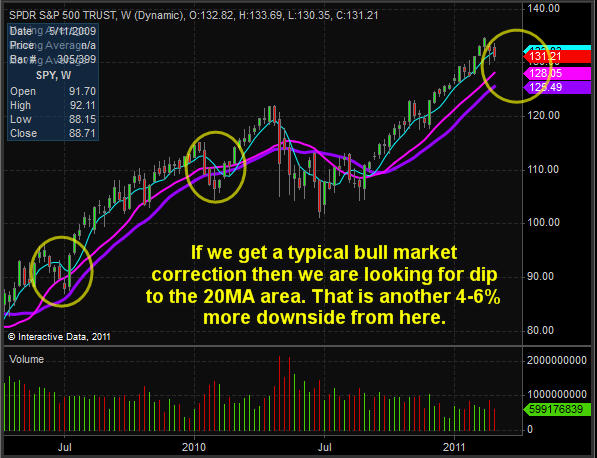 US Dollar Index - Weekly Chart The dollar is trading down at a key support level which I am keeping a close eye on. If we get a close below this trend line then we should see the dollar sell off sharply which in turn will trigger another leg higher in commodities across the board. 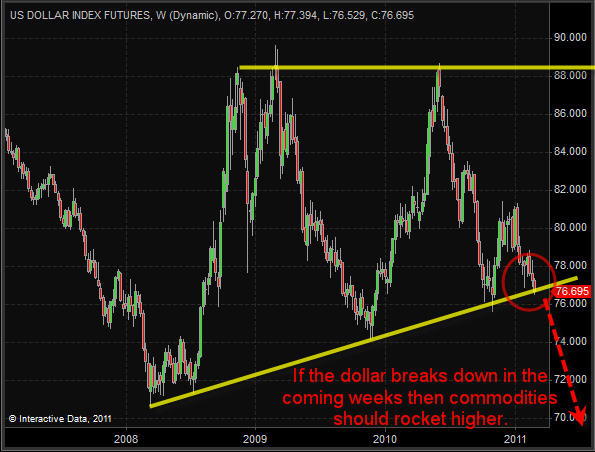 Crude Oil - Weekly Chart Crude oil has really taken off because of the fears coming out of the Middle East. From the looks of it the next key pivot level is the $110 level. 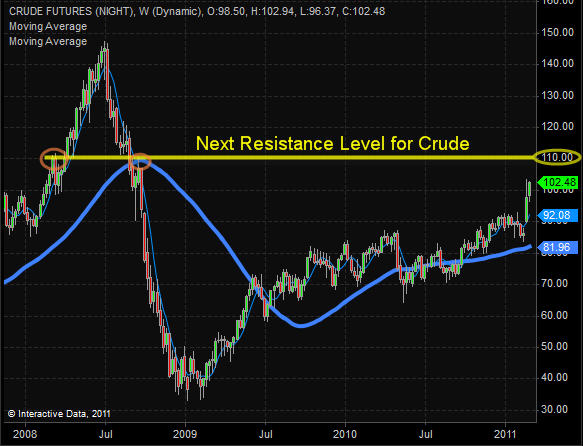 Gold - Daily Chart Both gold and silver have made new highs but after such a run I expect we see a quick pullback before they go higher. Gold and silver are the two investments I think everyone should hold a core position for the long run no matter what happens to the price. But, if we do get a nice quick pullback into the key moving averages then I think it's a great spot get involved with more money. 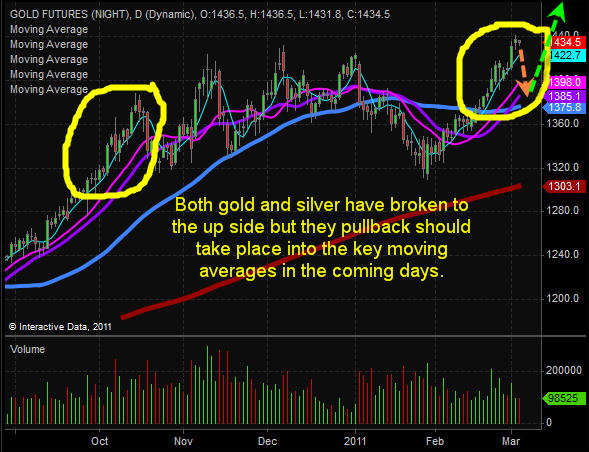 Mid-Week Trend Report In short, I am bullish on stocks and commodities and bearish on the dollar and bonds. The one issue I see going forward is that if the dollar breaks down it will most likely help boost oil prices which in turn puts downward pressure on stocks… So depending on how things unfold in the Middle East and a falling dollar, we may not see higher stock prices. Some individuals are forecasting $150-220 per barrel and I know if it gets back up there it will definitely slow the economy and stock prices down… That's it for now, but if you would like to these reports sent to your inbox be sure to join my free newsletter: www.thegoldandoilguy.com/trade-money-emotions.php Chris Vermeulen //for your reading pleasure.. |
| Useful To Me Not Useful To Me | |
|
bsiong
Supreme |
06-Mar-2011 11:00
Yells: "The Greatest Wealth is Health" |
|
x 0
x 0 Alert Admin |
WEEKEND DIGEST Phases Of Secret Gold Policy Dimitri Speck Intervention aimed at countering rising gold prices has occurred for many years. One of the reasons is efforts by central banks to quell doubts about monetary stability. Despite such primary objectives - leading characters, motives and times do not form a coherent unit. In particular there are clearly distinguishable phases. Phase I As early as 1993, worries circulated among central bankers over rises in the inflation-rate and the lasting functionality of the monetary system. The European Monetary System had collapsed and gold prices had increased dramatically during the first half of the year. There was a danger that a further increase in price would signal a rise in inflation and that, because of expectations, inflation would indeed return strongly. Some central banks, including the FED, agreed at the beginning of July not to tolerate gold prices above 400 dollars an ounce. Unperturbed, the price of gold marched higher topping the mark. The day had come: On August 5, 1993 at 8:27 AM (all time values are US Eastern time) the pact was put into action. Massive sales, mainly on the COMEX futures market in New York, triggered a price free-fall. The sudden drop was supposed to unsettle investors and persuade them to stay away from the gold market. To this day, sudden price pullbacks are a key characteristic of systematic gold market interventions. The following chart shows the intra-day price movement of gold on August 5, 1993, the beginning of the systematic interventions. 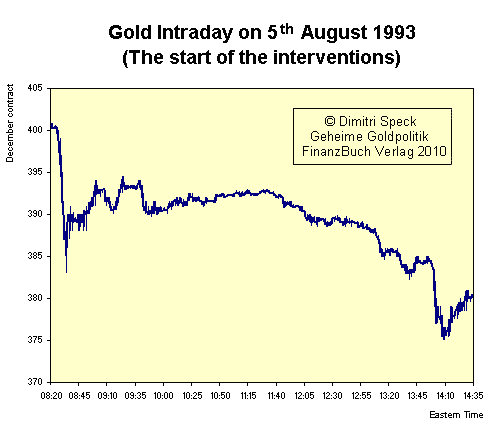 Figure 1: Gold Intraday on August 5, 1993 Phase II The physical metal required for pushing gold prices lower found its way to the market both through sales and lending activities. The so-called gold carry trade involves lending gold to interested market participants, who then sell it on the market using proceeds to invest in other higher-yielding assets. Since gold carry traders now owe gold they have a vested interest in seeing lower gold prices. If they can clear their books or back when prices are lower, they make a profit. That's why they started a lobby and media campaign aimed at achieving increased gold sales and lending and thus a fall in gold prices. One of the biggest holders of gold was the Swiss National Bank. When it announced its intention to sell gold, it signaled lasting lower prices in the metal. Thus the second phase began on November 21, 1996 at 10:01 A.M. 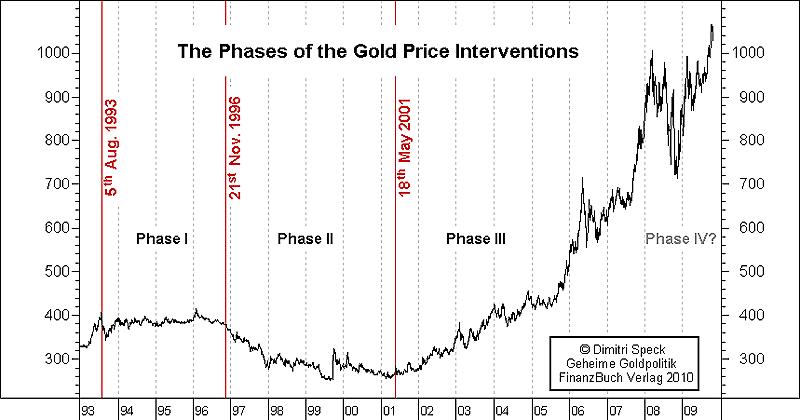 Figure 2: The phases of gold suppression One of the main characteristics of the second phase was the conflicting interests involved. Profit minded carry traders wanted lower gold prices, while central banks were satisfied with prices at least no longer falling. For that reason central banks increasingly fought against prices continuing lower even Greenspan, who was among the initiators of gold intervention, now spoke in favor of gold. The other side included carry traders and a few politicians, which led to gold sales by the UK. Despite the downward trend in gold, there was an upper price limit during the second phase which was pegged at 300 dollars per ounce. In addition there was agreement over a final year-end price of 290 dollars on the COMEX futures market. Phase III As gold stock piles at central bank vaults continued to dwindle it became obvious that prices could no longer continue to be held at low levels. That's why in May, 2001 the best known of the carry traders were informed that they would have to expect rising gold prices at the end of the year. What happened then could have come from the pages of a crime novel: Several large market participants looking to take advantage of the situation forced the carry traders out of their huge short gold positions as the price of the metal exploded. Their action commenced on May 18, 2001 at 12:31 PM, thus ringing in the third phase - and that, even though their last attempt to trigger a price explosion had ultimately failed on the dominance of the central banks. However now it was clear that in the long run gold prices could no longer be held down. What's more, since those very days the structure of the futures market has changed in an essential way. According to official US trading statistics, commercial traders are now markedly positioned on the sell side of the market on permanent basis. The following figure shows positioning of the " commercials" in the futures markets. 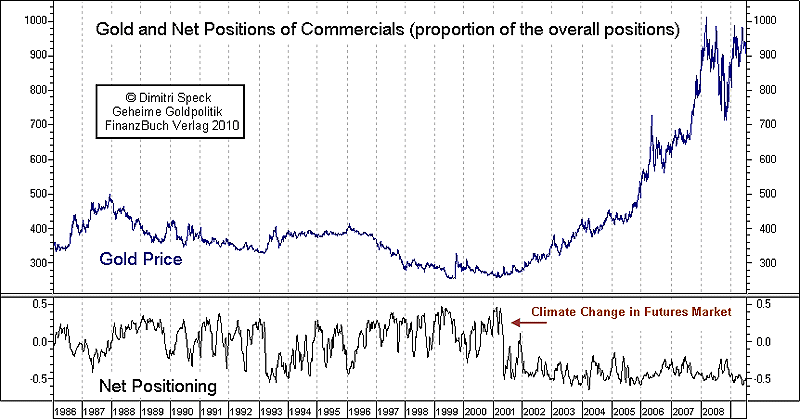 Figure 3: Net positioning of the commercials The third phase is typified by a climbing gold price. The goal now is no longer to hold prices steady or even to push them back down, but simply to prevent them from rising too rapidly. But also the strategy of supplying the market with stockpiles of central bank gold has changed. Until 2001, reserve banks had suppressed gold prices by selling and lending ever larger amounts of the physical metal to the market. But by doing so they had put themselves at risk: Loans were running at several times yearly consumption, an amount the banks could hardly take back through normal channels. That's why since 2001 central banks sell about as much as they are able to take back in loaned gold. In essence they return loaned gold back to themselves. Effectively since the third phase began, gold no longer finds its way back to the markets from the central banks. Gold's climb goes right along with it. Phase IV? Since 2008 the question has been whether we are now in the final phases of systematic gold intervention activities. In the wake of the financial crisis, large scale doubt about the stability of the currency system surfaced again for the first time in years. A rise in gold prices can still be prevented through massive interventions. There has also been far stronger intra-day price movement as in previous years. But what does gold have to do with the global crisis? To this, the final figure shows the entire world's debt compared with its economic potential. Included is not only the debt of countries, but also that of households and companies, because in the final analysis they also must be supported by economic potential. In addition the financial crisis has shown that the state must directly or indirectly accept private sector debt on its books in order to prevent collapse. 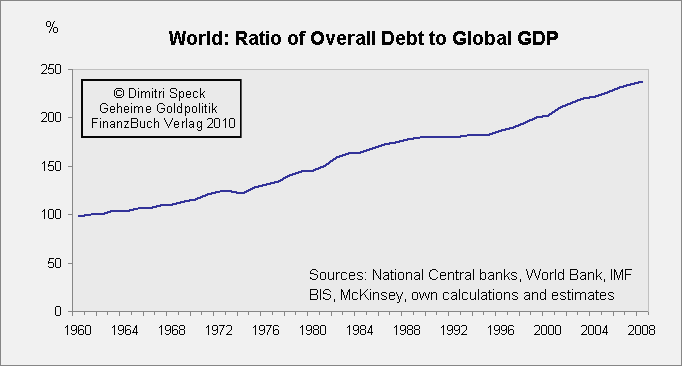 Figure 4: Total world debt compared to gross world product Since the 1960s, the world's total debt has more than doubled compared to global economic potential. Classically the end of this kind of credit bubble results in collapse and default. These days, nations generally act to prevent that in order to avoid strong deflation and crisis. What possible outcome is demonstrated by Japan, which as early as the 1990s, was mired in excessive debt similar to the way the entire world is today. In Japan, it ended in decade-long stagnation, but at least not in catastrophe (at least not yet). In the best case, even climbing out of debt is possible the way Great Britain did after the Second World War. However conditions in those days differed dramatically. Besides, globally speaking there has never been a measurable reduction of debt for decades now (even from much lower levels). That brings us to another road down which an over indebted economy can travel. It has to do with the Janus face of debt: One man's debt is another's certified claim. If inflation expectations increase these claims could end up in circulation, which would mean a sort of flight to material assets. Because of large holdings of debt paper, potential for demand is high and with it an accordingly high potential for an advance in prices. That type of scenario is still not visible on the horizon. But if it should come to that, gold's advantages as a non-replenishable and non-revalueable liquid asset would come to play - exactly the same advantages that have been motivating the central banks to execute interventions since 1993. March 3, 2011 Dimitri Speck |
| Useful To Me Not Useful To Me | |
|
bsiong
Supreme |
05-Mar-2011 08:32
Yells: "The Greatest Wealth is Health" |
|
x 0
x 0 Alert Admin |
Closing Gold & Silver Market Report – 3/4/2011March 4, 2011At 4:00 PM (CT) the APMEX precious metals spot prices were:
COMMENTARY: Precious metals end high today with news of continued protests and rebellious battles in the Middle East. Paris-based Interpol has now issued a global alert against Gaddafi and 15 members of his inner circle to help law enforcement around the world end the turmoil in Tripoli.Reporters at TheStreet went to some of America’s corporate leaders with the question “Will gold retain its lofty perch as an asset class?” Goldcorp’s CEO Chuck Jeannes responded: " I do. I think it's been re-emphasized to investors who perhaps forgot over the last few years that gold is a safe haven investment. It is an alternative currency, and it protects wealth in times of financial distress, and that's a lesson that I don't think will be lost anytime soon." This was just one of many similar responses. In spite of news that the jobless claims have dropped, the US stocks continue to fall and the DJIA is looking to make a second-straight weekly drop while oil prices surpass the dreaded $100 a barrel. Gold spot price is up $16.00 on the day. Silver is up $1.31. Platinum is up $10.70. Palladium is down $2.80. |
| Useful To Me Not Useful To Me | |
|
bsiong
Supreme |
04-Mar-2011 15:06
Yells: "The Greatest Wealth is Health" |
|
x 0
x 0 Alert Admin |
SINGAPORE, March 4 (Reuters) - Spot gold held steady on Friday, consolidating after falling more than 1 percent in the previous session, as investors await a key U.S. job market report to assess the health of the world's top economy. U.S. nonfarm payrolls data, due at 1330 GMT, is expected to show a strong increase in new jobs. It will come at the heel of upbeat weekly jobless claims data on Thursday. " If the payrolls data surprises on the downside, gold prices will continue to be supported," said a Tokyo-based trader. " If it is better than expected, it may put some pressure on prices." Spot gold edged up 0.2 percent at $1,417.89 an ounce by 0316 GMT, poised for a minor gain of 0.6 percent after a choppy week. U.S. gold futures also inched up 0.2 percent at $1,418.60 an ounce. Price of bullion fell by as much as 2 percent during a cross-commodity sell-off sparked by falls in oil following news of a proposed Venezuelan-brokered peace plan for Libya. That news sent Brent crude oil prices falling by more than $3 dollars in around an hour, before paring about half the loss on analyst scepticism about the success of such a plan.Gold is seen consolidating around current levels, as investors who hold bullish views on bullion take advantage of the price fall in the previous session." Inflationary fears globally will remain for the medium-long term, especially as inflation in large developing economies such as China, India and Brazil is already running high," said Li Ning, an analyst at Shanghai CIFCO Futures.She warned, however, some correction could take place after gold's strong rally over the past month or so. But, she said, gold should find strong support at the $1,400 level.Technical analysis showed that gold might be embarking on a correction which could extend to $1,374 next week, according to |
| Useful To Me Not Useful To Me | |
|
bsiong
Supreme |
04-Mar-2011 09:26
Yells: "The Greatest Wealth is Health" |
|
x 0
x 0 Alert Admin |
(Reuters) - Gold fell 1.5 percent on Thursday, snapping a four-day rally to record highs on news of a Venezuelan proposal to end turmoil in Libya and as the European Central Bank warned it could soon raise interest rates. Gold nearly halved its gains from the past four days which culminated in an all-time high $1,440.10 an ounce on Wednesday. Bullion investors took profits as oil prices slipped after Venezuela said Muammar Gaddafi had agreed to its proposal for an international commission to negotiate a peace plan in Libya, the world's 12th largest oil exporting nation. Bullion was also pressured by ECB President Jean-Claude Trichet's statement that the central bank would exercise " strong vigilance" over inflation and that interest rate increases could come at ECB's next meeting in April, far earlier than markets expected. Spot gold fell as low as $1,409.96 an ounce and was down 1.5 percent to $1,412.90 an ounce at 3:04 p.m. EST (2004 GMT). The metal fixed at $1,421.50 in London. U.S. gold futures for April delivery settled down $21.30 an ounce at $1,416.40, with turnover of more than 200,000 lots, some 10 percent higher than its 30-day average, preliminary Reuters data showed. Thursday marked the first time U.S. gold volume rose above 200,000 contracts since January 28. Trichet's remarks on inflation and a possible rate hike pushed the euro sharply higher against the dollar, edging toward the psychologically important $1.40 level. " This is the type of language that in previous rate hike cycles preceded a rate hike," said currency strategists at Action Economics. |
| Useful To Me Not Useful To Me | |
|
bsiong
Supreme |
04-Mar-2011 09:22
Yells: "The Greatest Wealth is Health" |
|
x 0
x 0 Alert Admin |
SINGAPORE, March 4 (Reuters) - Gold prices held steady on Friday, after falling sharply in the previous session, as investors watched the unfolding unrest in the Middle East and North Africa, as well the key U.S. payrolls data for clues of the health of the economy. FUNDAMENTALS * Spot gold was little changed at $1,416.44 an ounce by 0048 GMT. * U.S. gold futures held steady at $1,417.30. * The news that the European Central Bank may hike interest rates in April, far earlier than expected, combined with Venezuela's proposal to help end the turmoil in Libya, knocked down gold from a record of $1,440.10 hit on March 2. * Eyes are on the U.S. non-farm payrolls data, due later in the day to assess the recovery of the job market. * Holdings in the SPDR Gold Trust , the world's largest physically backed exchange-traded fund, fell to 1,210.621 tonnes, their lowest since mid-May last year. * Holdings in the iShares Silver Trust rose to two-month high of 10,794.89 tonnes. MARKET NEWS * Investors betting on a big gain in U.S. payrolls pushed Wall Street to its best one-day rally in three months on Thursday, but weak volume lingers as a concern for those hoping for another leg higher. * Oil prices held steady on Friday, after falling off 2-1/2-year highs on Thursday after Venezuela pitched a plan to resolve the Libyan crisis. * An explosive rally in the euro took a breather early in Asia on Friday ahead of influential U.S. jobs data, but the single currency is set to stay bid after the European Central Bank signalled an interest rate hike as early as next month. |
| Useful To Me Not Useful To Me | |
|
bsiong
Supreme |
04-Mar-2011 09:20
Yells: "The Greatest Wealth is Health" |
|
x 0
x 0 Alert Admin |
Closing Gold & Silver Report – 3/3/2011March 3, 2011At 4:00 PM (CT) the APMEX precious metals prices are:
COMMENTARY: Precious metal prices were down today, as the stock market climbed nearly 200 points. Jobs data and a renewed sense of optimism were the likely causes, but we cannot discount the reports of Venezuela brokering peace talks with Libya and the European Central Bank’s warning they could soon raise interest rates. News of the current SEC proposal to stop the trafficking of “conflict gold” took the market somewhat by surprise. Experts fear that the added rules, regulations, greater costs and auditing to be put in place to regulate the mining of gold in Tanzania could lead to an unintended boycott of African gold mining. Gold spot price is down $21.90 – Silver price is down 62 cents – Platinum spot price is down $31.40– Palladium price is down $7.80 |
| Useful To Me Not Useful To Me | |

